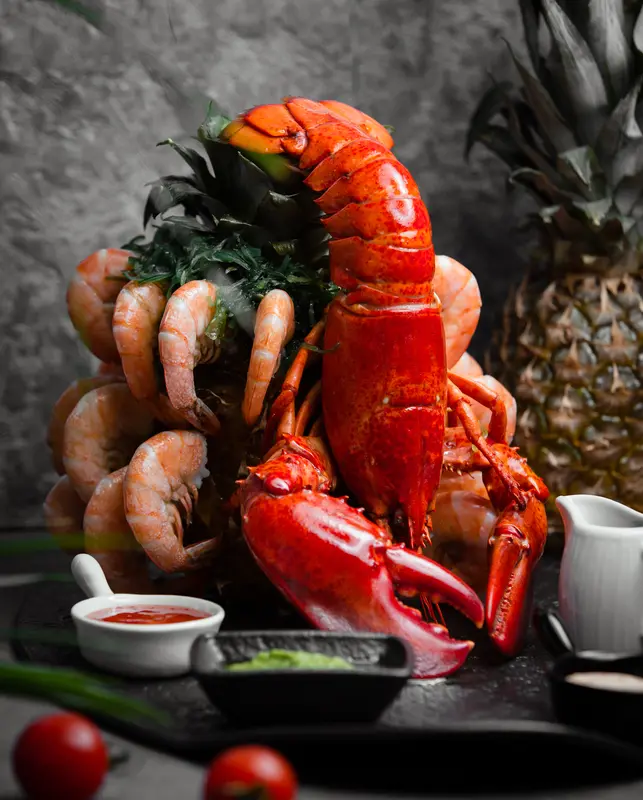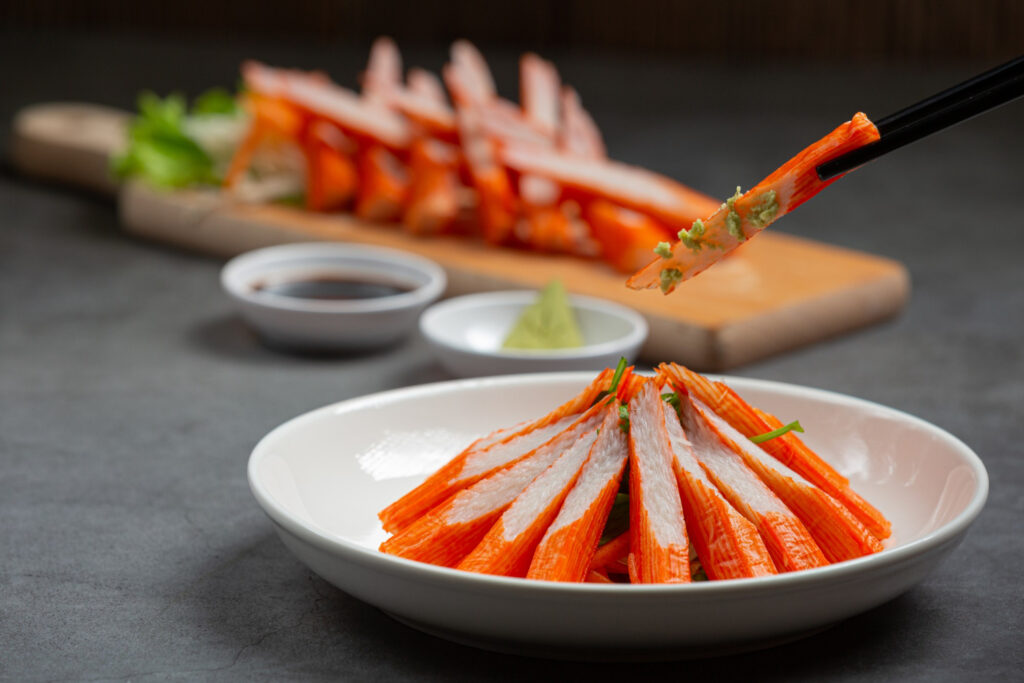Introduction to Imitation Crab Recipes
Welcome to the fascinating world of imitation crab recipes, a realm where innovation and versatility take center stage. Known as surimi in Japanese, imitation crab transcends its role as a mere substitute for crab meat, embodying a canvas for culinary creativity. Blending tradition with innovation, it offers an accessible and diverse seafood experience. From being the highlight in California sushi rolls to a comforting element in creamy pasta and the secret touch in festive seafood salads, imitation crab has a unique tale in each dish.
In this guide, we will delve into what elevates imitation crab to a favorite in kitchens across the globe. We’ll explore its composition, journey from fish to faux crab, and how it seamlessly integrates into various culinary traditions. Furthermore, we’ll uncover the nutritional aspects of surimi, compare it with real crab, and discuss its role in diverse diets.
Spanning from sushi bars in Tokyo to family dinners in the American Midwest, imitation crab crosses culinary borders and cultures, exemplifying the creativity and adaptability inherent in the culinary world. Join us as we explore the versatility, flavor, and sheer joy that imitation crab brings to cooking.
The Rise of Imitation Crab in Global Cuisine
Imitation crab, or surimi, has experienced a remarkable ascent in global cuisine, securing its place in a multitude of culinary traditions. This journey is a testament to innovation, economic factors, and cultural adaptation.
Early Origins and Innovation
Tracing its origins back to Japan, where it began as a method to preserve fish, surimi underwent significant transformation in the 1970s. It evolved into a crab meat alternative using affordable fish like pollock, driven by the need for a cost-effective crab substitute.
Economic Factors
The 1980s marked a pivotal moment as imitation crab entered the American market, swiftly gaining popularity due to its affordability compared to real crab meat. This cost-effectiveness, combined with its versatility and convenience, widened its appeal, enabling a broader audience to savor a seafood experience without the hefty price tag.
Global Culinary Integration
Imitation crab ventured beyond Japan and the United States, integrating into European and Asian cuisines. In Europe, it became a staple in seafood salads and pasta dishes, while in Asia, particularly in sushi rolls like the California roll, it played a significant role in popularizing sushi internationally.
Cultural Adaptation and Fusion Cuisine
The imitation crab’s rise is marked by its adaptability. Chefs and home cooks have ingeniously incorporated it into traditional dishes, giving rise to fusion cuisines. This adaptability demonstrates surimi’s capacity to blend with a range of flavors and ingredients, catering to diverse palates and culinary preferences.
Sustainability and Future Trends
As concerns over seafood sustainability grow, imitation crab offers a more environmentally friendly option compared to some overfished crab species. Looking forward, this aspect, along with ongoing culinary innovation, points to a bright future for imitation crab in global cuisine.
Why Choose Imitation Crab?
Opting for imitation crab in cooking extends beyond its economic advantages. It stands out for various compelling reasons, securing its place as a staple in many kitchens worldwide.
Affordability
The imitation crab’s cost-effectiveness is a significant draw. Unlike real crab, often a luxury item due to factors like seasonality and fishing regulations, imitation crab offers a similar taste and texture at a more affordable cost, using readily available fish like pollock.
Convenience and Ease of Use
As a pre-cooked and ready-to-eat option, imitation crab is a convenient choice for quick and effortless meals. It eliminates the need for the tedious cleaning and cooking associated with fresh crab, easily blending into salads, pasta, and other dishes.
Dietary and Allergen Considerations
For those with shellfish allergies, imitation crab emerges as a safe alternative, although it’s essential to check for any potential shellfish extracts in the ingredients. It also provides a lower-cholesterol option, appealing to those monitoring their cholesterol intake.
Versatility in Recipes
With its mild flavor and adaptable texture, imitation crab proves to be a versatile ingredient. It can complement a wide range of dishes without overpowering other ingredients, fitting seamlessly into various cuisines and cooking styles.
Sustainability
In light of overfishing concerns and seafood sustainability, imitation crab presents a more eco-friendly choice. Made from typically more abundant and sustainably harvested fish species, it aligns with the preferences of environmentally conscious consumers.
Unraveling the Mystery of Imitation Crab Recipe
What is Imitation Crab (Surimi)?
Imitation crab, a staple in many seafood dishes, is an ingenious creation known as surimi. But what exactly is it? Surimi is a processed seafood product, typically made from white fish like pollock, which is ground into a fine paste and flavored to mimic the taste and texture of crab meat. The magic of surimi lies in its ability to offer a seafood experience that’s both affordable and versatile, making it a popular choice in various cuisines around the world.
The Process of Making Imitation Crab
The journey of surimi from fish to faux crab is a fascinating one. It starts with deboning and rinsing the fish to remove any impurities. The fish is then minced, and ingredients like starch, egg whites, and crab flavoring are added to create a paste. This paste is shaped and colored to resemble crab meat, often using food colorings to achieve the characteristic pink and white hues.
Key Ingredients in Surimi
While the base of surimi is fish, its transformation into imitation crab involves several other ingredients. These typically include sugar, salt, and various additives that help stabilize and preserve the product. Each manufacturer might have a slightly different recipe, which can affect both the flavor and texture of the final product.
The Nutritional Profile of Imitation Crab
Imitation crab is not only a culinary chameleon but also an interesting item from a nutritional standpoint. It’s low in calories and fat, making it an appealing choice for those on a calorie-conscious diet. However, it’s worth noting that surimi doesn’t provide the same omega-3 fatty acids and other nutrients found in real crab meat.
Comparing Imitation Crab and Real Crab
When it comes to nutrition, real crab and imitation crab have distinct differences. Real crab boasts a higher protein content and a richer array of vitamins and minerals. On the other hand, imitation crab is a more carbohydrate-focused option due to the added starches. For those with dietary restrictions or allergies, it’s essential to consider these differences when choosing between the two.
Culinary Techniques for Imitation Crab
Basic Cooking Techniques with Imitation Crab
Imitation crab, known for its versatility, can be used in a myriad of culinary applications. Let’s explore some basic cooking techniques that can transform this simple ingredient into a gourmet delight.
Sautéing, Baking, and Grilling
Sautéing imitation crab with garlic and butter brings out a rich flavor that’s perfect for pasta dishes or warm salads. Baking is ideal for creating casseroles and dips, where the surimi can blend with cheeses and creams. Grilling, though less common, can add a smoky flavor to imitation crab, excellent for BBQs and outdoor events.
Advanced Culinary Uses of Imitation Crab
For those who wish to push the culinary boundaries, imitation crab offers a world of possibilities. Incorporating surimi into gourmet dishes can be a delightful experiment.
Incorporating Surimi in Gourmet Dishes
Consider using imitation crab in sophisticated dishes like bisques or sushi rolls. The texture and flavor of surimi can elevate these dishes, making them suitable for fine dining experiences. Experimenting with different herbs and spices can also lead to the creation of unique dishes that highlight the versatility of imitation crab.
Imitation Crab Across the World’s Cuisines
The versatility of imitation crab has allowed it to seamlessly integrate into a variety of world cuisines, each bringing its own unique flavors and traditions to the table.
Imitation Crab in Japanese Cuisine
In Japan, where surimi originated, imitation crab is a key ingredient in many dishes. It’s most famously used in sushi, particularly in rolls like the California roll, which has been instrumental in popularizing sushi around the world.
Sushi and Beyond: Surimi in Japanese Delicacies
Beyond sushi, surimi finds its place in other Japanese dishes such as salads, tempura, and various noodle dishes. Its ability to absorb flavors makes it an excellent component in the delicate balance of Japanese cuisine.
Imitation Crab in Western Cooking
The adaptation of imitation crab in Western cooking showcases the ingredient’s versatility. From the United States to Europe, surimi has been embraced in a variety of ways.
American and European Twists on Imitation Crab Recipes
In the United States, imitation crab is a popular addition to salads, casseroles, and seafood pasta dishes. In Europe, particularly in Mediterranean countries, it’s often found in seafood paellas, risottos, and as a filling in sandwiches and wraps.
Fusion and Innovative Imitation Crab Dishes
The fusion cuisine movement has further expanded the use of imitation crab, blending Eastern and Western culinary traditions. Innovative chefs have used surimi in unique ways, creating dishes that defy traditional categorization.
Experimenting with Flavors and Textures
The mild taste and adaptable texture of imitation crab make it ideal for experimentation. Chefs have combined it with bold spices, fresh herbs, and a variety of sauces, creating dishes that are both familiar and new.
Health and Sustainability: A Closer Look
In recent years, health and sustainability have become crucial factors in choosing food products. Imitation crab, with its unique production and nutritional profile, offers interesting points in both these aspects.
The Health Benefits and Considerations of Imitation Crab
Is Imitation Crab a Healthy Choice?
Imitation crab is low in calories and fat, making it an attractive option for calorie-conscious diets. It’s also a good source of protein. However, it’s important to note that it’s higher in carbohydrates and lower in protein compared to real crab meat due to the starches and fillers used in its production. For those monitoring their sodium intake, it’s also worth noting that surimi often contains higher levels of sodium.
Sustainability and Environmental Impact
Surimi as an Eco-Friendly Seafood Alternative
One of the compelling arguments for the use of imitation crab is its sustainability. It’s made from fish like Alaskan pollock, which are typically more sustainably fished and abundant compared to crab populations, which can be subject to overfishing and other environmental concerns. This makes imitation crab a more environmentally responsible choice in seafood.
The Role of Surimi in Responsible Seafood Consumption
The production of imitation crab also involves less wastage compared to real crab, as it uses the entire fish. This efficiency is another point in its favor from a sustainability perspective.
Creative Recipes and Pairings with Imitation Crab
Imitation crab’s unique texture and flavor make it a versatile ingredient in the kitchen, leading to a wide array of creative and delicious recipes.
Simple Yet Delicious Imitation Crab Recipes
Imitation crab shines in its simplicity, starring in a variety of easy-to-make dishes that are both tasty and satisfying.
Quick and Easy Meals for Busy Days
For a quick lunch, a classic imitation crab salad with mayonnaise, celery, and a hint of lemon is perfect. Furthermore, surimi works well in simple stir-fries, combined with vegetables and a savory sauce. These recipes are not only easy to prepare but also offer a delightful taste experience.
Exquisite Pairings with Imitation Crab
The mild taste of imitation crab beautifully complements a range of flavors and ingredients, allowing for culinary creativity in pairing.
Wine and Beverage Recommendations for Imitation Crab Dishes
A light white wine, like a Pinot Grigio or Chardonnay, harmonizes with the delicate flavor of surimi. Additionally, for non-alcoholic options, a crisp iced tea or a sparkling lemonade can provide a refreshing balance to the dish’s flavors.
Imitation Crab in Festive Cooking
Imitation crab can also play a significant role in festive and celebratory meals, adding a touch of elegance to appetizers and main courses.
Celebratory Meals and Party Snacks with Surimi
For party snacks, imitation crab dip or sushi rolls are sure to please crowds. Moreover, in more formal settings, a surimi-stuffed fish or a sophisticated imitation crab bisque can elevate any dining experience.
Conclusion: Embracing the Versatility of Imitation Crab
As we conclude our exploration of imitation crab recipes, it’s clear that this versatile ingredient has a significant impact on global cuisine. Originating from a Japanese innovation, it has gained widespread popularity across various cultures, proving itself as more than just a cost-effective substitute for real crab.
The Future of Imitation Crab in Culinary Arts
The future is bright for imitation crab in culinary arts. With a continuous focus on sustainability and increasing culinary creativity, chefs and home cooks will keep finding surimi an essential ingredient. Its versatility, along with environmental and economic benefits, is likely to inspire a host of new and innovative dishes.
Your Journey with Imitation Crab Recipes
Whether you’re a professional chef or a home cook, the world of imitation crab offers endless possibilities for culinary creativity. The simplicity and adaptability of surimi foster endless experimentation and discovery in the kitchen. From comforting home-cooked meals to sophisticated dining experiences, imitation crab can elevate any dish.
In conclusion, imitation crab stands as a testament to culinary innovation and adaptability, having evolved from a simple Japanese fish paste into a beloved ingredient in kitchens worldwide. As you continue to explore and experiment with imitation crab recipes, each dish contributes to this rich and evolving culinary story.




